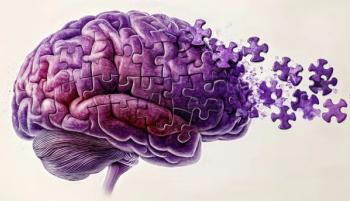
- Vol 31 No 4
- Volume 31
- Issue 4
A Dark Side of Dementia Care
Placing black floor mats in front of exits to deter demented nursing home residents from dangerous wandering may pose ethical questions.
“When am I going home?”
“We’re just trying to arrange the transportation.”
“When is my husband going to visit?”
“He’s away on business for a few days.”
“Why can’t I go over there?”
“Because you will fall into a bottomless black pit.”
[[{"type":"media","view_mode":"media_crop","fid":"23938","attributes":{"alt":"","class":"media-image media-image-right","id":"media_crop_6095069651","media_crop_h":"0","media_crop_image_style":"-1","media_crop_instance":"2003","media_crop_rotate":"0","media_crop_scale_h":"0","media_crop_scale_w":"0","media_crop_w":"0","media_crop_x":"0","media_crop_y":"0","style":"width: 150px; height: 186px; float: right;","title":" ","typeof":"foaf:Image"}}]]Asked by a reader of The New York Times about the ethics of placing black floor mats in front of exits to deter demented nursing home residents from dangerous wandering, ethicist Chuck Klosterman1 acknowledged that this behavioral intervention is based on deception. On balance, however, he expressed support for a maneuver that might be preferable to more restrictive alternatives, such as chemical or physical restraints. From an ethical standpoint, he considered the mats a way of maximizing independence. He saw no “downside that isn’t purely theoretical.” As clinicians who work with geriatric patients, we’d like to explore the possible downside, even though it may be only theoretical.
Therapeutic lies, or fiblets, are often used to reduce stress and manage the anxieties and disruptive behaviors of demented inpatients, long-term–care residents, or the elderly who are cared for at home, who are not reassured by simple distraction or redirection. When an inpatient or long-term–care resident tries to leave a facility, sometimes with the intent of returning to a home that no longer exists, a fiblet can reduce suffering and offer comfort. An agitated widow seeking her deceased husband high and low in a nursing home may feel much less distress if told that staff will help her look for her husband later but in the meantime she is needed to help set the table for dinner. When “later” arrives, the urgency that drove the woman’s search may have waned considerably. The first two interactions at the start of this article are accepted commonplace, anxiety-reducing fiblets. The third, a verbal interpretation of the visual deception created by a black mat, is a threat rather than a distraction.
Demented patients’ avoidance of dark mats, tiles, or even lines on the floor has long been observed-and sometimes exploited clinically-although we could not locate any studies of the effectiveness and safety of this maneuver. Patients avoid the dark mat because they visually misinterpret the blackness as a drop-off, the socalled visual cliff. Experimental observations of behaviors associated with the visual cliff in infants and in animals shed light on how we might understand the experience of a demented person faced with an unexpected chasm where floor had been expected.
At 5 months of age, infants placed near a visual cliff explore it more or less boldly, but by 9 months a fear reaction is seen.2 The heart rate acceleration associated with this experience may represent fear, although alternative explanations have been proposed. Unambiguous fear reactions have been documented in animals subjected to this experience. Kittens and goats placed atop the deep side of a visual cliff displayed freezing and limb tensing.3 Rhesus monkeys placed on the deep side of the cliff showed crouching, distress vocalizations, self-clasping, and rocking behavior.4
Cognitively impaired older adults are not infants or animals, of course, but in some respects their cognitive functions have retrogressed to a stage in which analytic thinking is more limited and catastrophic reactions are more likely than with cognitively intact adults. That persons with dementia might react fearfully to a visual cliff should not surprise us, when we think about the subjective experience of a disoriented person who may also have gait and balance problems and difficulty with visual contrast and interpretation. Many of our cognitively impaired patients also have had terrifying experiences with previous falls. Phobic anxiety, with or without insight, may remain as an emotional response.
In some long-term–care facilities, the concealment of doors by curtains or pictures has reduced exit-seeking behavior. Other doors, visible to patients, can lead to a garden or circular path suitable for walking. A dark mat blocking an exit, however, differs from concealment of an exit or from the technique of redirection with an arrow or a “Do Not Enter” sign on the door. The mat is a visual deception that, we might imagine, could evoke fear in a cognitively impaired person. In principle, though more gently, an apparent pit in front of a door serves the same purpose that we might have achieved by posting a holographic image of a charging rhinoceros on a door’s center panel. Why do we avoid using the ostensibly harmless rhino?
One of my colleagues, a dementia unit nurse director whose office sports a dark blue carpet, has observed the timidity and apprehension with which patients step into her room. An unsteady gait could be further destabilized in such a situation. Less likely but more frighteningly, what might happen to a demented person whose exit has been blocked by a dark floor covering in the event of a fire? Would he or she balk at taking the apparent risk required in order to exit safely?
Lies that reduce suffering and stress in patients unable to fully appreciate the cause of distress can be beneficial. Clinicians sanction their use in dementia care and see them as a manifestation of the ethical imperatives of beneficence and non-malfeasance.5,6 Whether the use of dark mats is a benign alternative of this sort or whether it might inadvertently invoke a fear reaction can easily be tested. Until such testing provides evidence of safety and effectiveness, the use of these mats for behavioral control should be regarded as an intervention of unproven acceptability.
Disclosures:
Dr Ellison is Director of the Geriatric Psychiatry Program at McLean Hospital in Belmont, Mass. Dr Hsu is a Clinical Fellow in the Partners Geriatric Psychiatry Fellowship Program in Boston. They report no conflicts of interest concerning the subject matter of this article.
References:
1. Klosterman C. Nursing-home pitfalls. New York Times Magazine. March 2, 2014:MM17.
2. Schwartz AN, Campos JJ, Baisel EJ Jr. The visual cliff: cardiac and behavioral responses on the deep and shallow sides at five and nine months of age. J Exp Child Psychol. 1973;15:86-99.
3. Gibson EJ, Walk RD. The “visual cliff.” Sci Am. 1960;202:64-71.
4. Rosenblum LA, Cross HA. Performance of neo-natal monkeys in the visual cliff-situation. Am J Psychol. 1963;76:318-320.
5. Culley H, Barber R, Hope A, James I. Therapeutic lying in dementia care. Nurs Stand. 2013;28:35-39.
6. Tuckett AG. The experience of lying in dementia care: a qualitative study. Nurs Ethics. 2012;19: 7-20.
Articles in this issue
over 11 years ago
Tips for Conducting Disability Evaluationsover 11 years ago
Pain, Opioids, and Psychiatristsover 11 years ago
Ketamine Anesthesia for Electroconvulsive Therapyover 11 years ago
Chronic Traumatic Encephalopathy: Should We Be Worried?over 11 years ago
Epilepsy and Seizures: Neuropsychiatric Implicationsover 11 years ago
Management of Psychosis in Parkinson Diseaseover 11 years ago
Computerized Neurocognitive Tests in Clinical Practiceover 11 years ago
What Is the Role of Vitamin D in Depression?over 11 years ago
Clinical Assessment of Dysexecutive SyndromesNewsletter
Receive trusted psychiatric news, expert analysis, and clinical insights — subscribe today to support your practice and your patients.

















